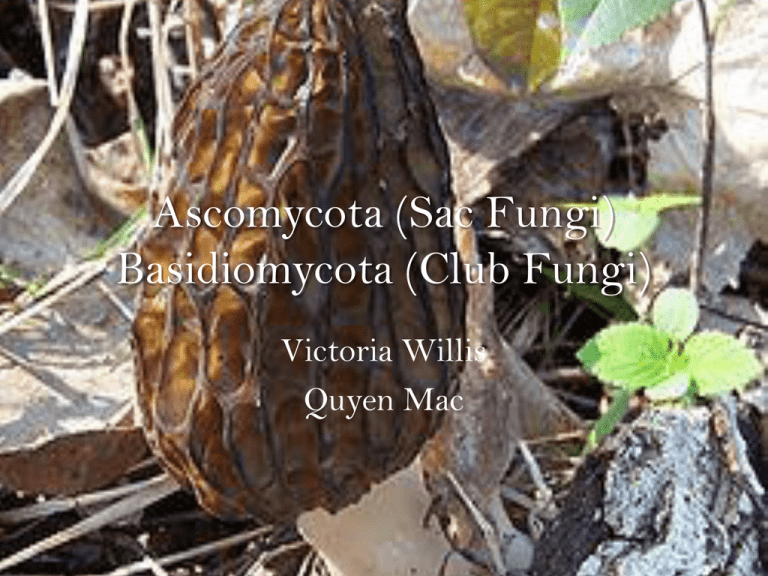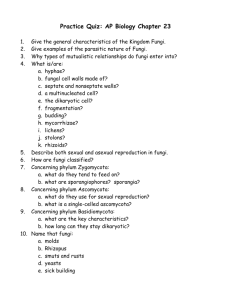
Ascomycota (Sac Fungi)
Basidiomycota (Club Fungi)
Victoria Willis
Quyen Mac
Structure
Densely interwoven hyphae (microscopic walled tubes or
filaments that are lined with plasma membrane and
contain cytoplasm) which form the fungal body
Hyphae branch into mycelium which are the feeding
network of the fungus
Cell walls made of chitin (a nitrogen containing
polysaccharide)
Hyphae may have septa (cross walls used for more
strength)
They have the ability to change their form according to
environmental conditions…this trait is called
dimorphism
They are haploid, but some can be diploid
Structure
• The basidium is the sexual reproductive structure.
Club-shaped.
• (a). Some basidia are transversely divided into 4 cells
(b). Some are longitudinally divided into 4 cells (c), and
others are shaped like a tuning fork (d).
•
•
•
•
Basidiospores are the four haploid products of meiosis.
4 basidiospores are borne on one sterigma.
Spore germinates forming homokaryotic hyphae.
No other group of fungi has septal structures called
clamp connections.
Diversity of Ascomycota
Kingdom Fungi
Other phyla groups include:
Basidiomycota and Zygomycota
Produce spores in a distinctive type of
microscopic sporangium called an ascus.
Examples of Sac Fungi: yeast,
morels, truffles and Penicillium
Diversity
• Kingdom Fungi
• Three classes: Basidiomycetes, Teliomycetes (rusts), and
Ustomycetes (smuts)
• Four artificial classes: Hymenomycetes, Gasteromycetes,
Urediniomycetes/Pucciniomycetes, and Ustilaginomycetes.
• Hymenomycetes contains fruiting bodies of basidia. Ex: crust fungi
• Gasteromycetes- the hymenium is enclosed until spores have
matured. Ex: puffballs.
• Urediniomycetes causes plant rust. Ex: Cronartium (rust)
• Ustilaginomycetes are smut fungi.
• Some are luminescent, hallucinogenic, lichenized, nematophagous,
or aquatic.
Mode of Nutrition
Heterotrophic
Acquire all nutrients by absorption
and secrete hydrolytic enzymes to
decompose complex molecules
Fungi act in 1 of 3 niches: saprobe,
parasite, or mutualistic.
-Saprophytic fungi
tend to decompose nonliving
organic material.
-Parasitic fungi
obtain nutrients from their living
host's cells.
-Mutualistic fungi
absorb materials from a living
organisms but provide beneficial
services for their host.
Mode of Nutrition
• Mycorrhizae is the result from a symbiosis
between a plant root and a funvus.
• The fungus would supply nitrogen-containing
compounds to the plant.
• The plant would supply carbohydrates and
other organic compounds to the fungus.
Reproduction
Sexual
Asexual (through budding)
1.
Small portion of the cell
membrane and cytoplasm receive
a nucleus.
2.
They pinch off from the parent
cell.
3.
Spore formation takes place on
conidiophores.
4.
Septae of terminal cells become
fully defined.
5.
Then divide a random number of
nuclei into individual cells.
6.
The cell walls thicken into a
protective coat.
7.
Spores then break off and
disperse.
1. Have male and female gametangia in haploid
stage.
2. These structures form the mycelia.
3. Plasmogamy then takes place when the
trichogyne fuses with the antheridium and
produce the binucleate.
4. Series of dikaryotic cells called an ascogonius
hypha is produced.
5. At the tip of this hyphae, nuclear fusion takes
place to form diploid asci.
6. Diploid nucleus undergoes meiosis producing
four haploid nuclei.
7. Nuclei undergo mitosis to form eight haploid
ascopores.
Reproduction (basidiomycota)
• Life cycle continues with the production of homokaryotic hyphae
after spore germination.
• Asexual reproduction is rare.
• Basidiospores are produced on basidia.
• Basidiospores germinate to produce monokaryotic hyphae.
• Hyphae fuse to form dikaryotic hyphae. Mushrooms re composed
of this.
• Dikaryotic nuclei fuse to produce a zygote and meiosis would
produce basidiospores.
Ecological Significance
Digests resistant materials such as cellulose (in
plant cells), lignin (found in wood) and
collagen (connective tissue found in animals)
Half of the species of Ascomycota form lichens
(a symbiotic relationship between a fungus
and a photosynthetic cell)
Ecological Significance
• They are the most important decayers of living
and dead wood in forests and buildings.
• Primary fungal partners in symbiotic
ectomycorrhizal associations with tree root.
What makes it different?
A unique factor present in Ascomycota are
Woronin bodies (separate the hyphal
segments which control these septal
pores). If an adjoining hypha is ruptured, the
Woronin bodies block the pores to prevent
loss of cytoplasm
Uniqueness
• Distinguished from other fungi by their production of
basidiospores.
• There are 22000 named species.
• Cause severe plant diseases, mushrooms (edible and
poisonous), boletes, puffballs, stinkhorns, chanterelles, false
truffles, jelly fungi, bird's-nest fungi, and conk or bracket fungi
Examples
• Saccharomyces cerevisiae: the yeast used for the
baking and brewing industries
• Penicillium chrysogenum: producer of penicillin
• Cryphonectria parasitica: a parasitic fungi
responsible for the demise of 4 billion
chestnut trees in the eastern USA
• Morchella esculentum: the edible morel
(mushroom)
Examples of club fungus:
• Poria cocos- touch or woody but edible.
• Tilletia tritici- permeate healthy grain with a
fishy odor
• Puccinia graminis- black stern rust of wheat
and other grains
• Hemileia vastatrix- coffee rust
References
•
•
•
•
•
•
•
•
•
•
•
•
•
•
•
•
Ascomycota. (1995-2004). Retrieved 02 17, 2012, from Tol Web: http://tolweb.org/Ascomycota
Ascomycota. (1995-2010). Retrieved 02 15, 2012, from About ScienceDaily: http://www.sciencedaily.com/articles/a/ascomycota.htm
Fungi. (n.d.). Retrieved 02 17, 2012, from SUNY:
http://faculty.clintoncc.suny.edu/faculty/michael.gregory/files/bio%20102/bio%20102%20lectures/fungi/fungi.htm
Fungi Structure. (n.d.). Retrieved 02 15, 2012, from faculty.college-prep.org: http://faculty.collegeprep.org/~bernie/sciproject/project/Kingdoms/Fungi5/Fungi_Structure.htm
RESEARCHES ON WOOD-DESTROYING FUNGI DIVISION. (2005). Retrieved 02 17, 2012, from dioserbia: http://www.doiserbia.nb.rs/img/doi/03524906/2005/0352-49060519143P.pdf
The Ascomycota - 1. (No Rights Reserved). Retrieved 02 17, 2012, from Palaeos: http://palaeos.com/fungi/ascomycota/ascomycota.html
Bracket Fungi. (n.d.). Retrieved 02 21, 2012, from Facts On File News Services: http://www.2facts.com/article/xbr157300a
Smut Fungi. (n.d.). Retrieved 02 21, 2012, from Facts On File News Services: http://www.2facts.com/article/xsm133500a
Basidiomycota. (n.d.) Retrieved 02 21, 2012, from AccessScience:
http://accessscience.com/abstract.aspx?id=074000&referURL=http%3a%2f%2faccessscience.com%2fcontent.aspx%3fsearchStr%3dBasidiomycota%
26id%3d074000
Basidiomycota. (n.d.) Retrieved 02 21, 2012, from nettrekker:
http://school.nettrekker.com/goExternal?np=/external.ftl&pp=/error.ftl&evlCode=264250&productName=school&HOMEPAGE=H
Fungi. (n.d.) Retrieved 02 21, 2012, from nettrekker:
http://school.nettrekker.com/goExternal?np=/external.ftl&pp=/error.ftl&evlCode=282853&productName=school&HOMEPAGE=H
Fungi. (n.d.). Retrieved 02 21, 2012, from Facts On File News Services:
http://www.2facts.com/icof_story.aspx?PIN=xfu096000a&term=basidiomycota
Fungi- Basidiomycota, Club Fungi. (n.d.) Retrieved 02 21, 2012, from http://science.jrank.org: http://science.jrank.org/pages/2894/FungiBasidiomycota-club-fungi.html
Raven Johnson, R.J. 2002. “Fungi.” Biology, Sixth Edition. New York. McGraw-Hill.
Snyder Sachs, J. (2011). Kingdom Fungi. The New Book of Popular Science. Retrieved February 22, 2012, from Grolier Online
http://nbps.grolier.com/cgi-bin/article?assettype=t&assetid=40176
Taber, R. A., & Taber, W. A. (2012). Fungi. Grolier Multimedia Encyclopedia. Retrieved February 22, 2012, from Grolier Online
http://gme.grolier.com/article?assetid=0114330-0
Picture References
•
•
•
•
•
•
•
•
•
•
•
•
(n.d.). Retrieved 02 21, 2012, from nicerweb.com:
http://bio1151.nicerweb.com/Locked/media/ch31/31_20BasidioLifCycl.jpg
(n.d.). Retrieved 02 21, 2012, from Tol Web: http://tolweb.org/tree/ToLimages/lifecycle.2.gif
(n.d.). Retrieved 02 21, 2012, from SUNY: http://faculty.clintoncc.suny.edu/faculty/michael.gregory/files/bio
102/bio 102 lectures/fungi/basidiomycota.gif
(n.d.). Retrieved 02 21, 2012, from SUNY: http://faculty.clintoncc.suny.edu/faculty/michael.gregory/files/bio
102/bio 102 lectures/fungi/img005.gif
(n.d.). Retrieved 02 21, 2012, from Palaeos: http://palaeos.com/fungi/images/Ascomycota.jpg
(n.d.). Retrieved 02 21, 2012, from Science Daily: http://images.sciencedaily.com/2011/03/110303120855.jpg
(n.d.). Retrieved 02 21, 2012, SUNY: from http://faculty.clintoncc.suny.edu/faculty/michael.gregory/files/bio
102/bio 102 lectures/fungi/peziza_X_200_small.jpg
(n.d.). Retrieved 02 21, 2012, from SUNY: http://faculty.clintoncc.suny.edu/faculty/michael.gregory/files/bio
102/bio 102 lectures/fungi/penicillium_conidia_X_400_small.jpg
(n.d.). Retrieved 02 21, 2012, from SUNY: http://faculty.clintoncc.suny.edu/faculty/michael.gregory/files/bio
102/bio 102 lectures/fungi/yeast_budding_X_1000_small.jpg
(n.d.). Retrieved 02 21, 2012, Palaeos: from http://palaeos.com/fungi/glossary/images/Mushrooms.jpg
(n.d.). Retrieved 02 21, 2012, from SUNY: http://faculty.clintoncc.suny.edu/faculty/michael.gregory/files/bio
102/bio 102 lectures/fungi/morel_small.jpg
(n.d.). Retrieved 02 21, 2012, from SUNY: http://faculty.clintoncc.suny.edu/faculty/michael.gregory/files/bio
102/bio 102 lectures/fungi/mushroom_showing_gills_small.jpg




